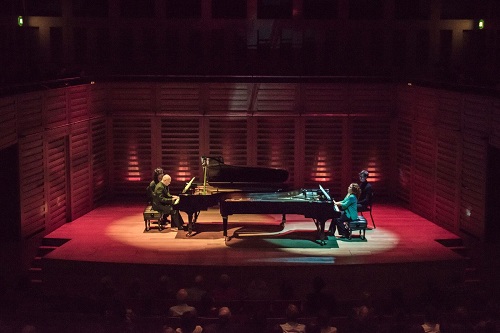 United Kingdom London Piano Festival – Schubert, Granados, Ginastera, Ravel, Debussy, Milhaud: Charles Owen & Katya Apekisheva (piano), Kings Place, London, 3.10.2018. (CS)
United Kingdom London Piano Festival – Schubert, Granados, Ginastera, Ravel, Debussy, Milhaud: Charles Owen & Katya Apekisheva (piano), Kings Place, London, 3.10.2018. (CS)

Schubert – Six Moments Musicaux D780 (Nos.1-3)
Granados – Goyescas: ‘Quejas, o La Maja y el ruiseñor’
Ginastera – Three Argentinian Dances Op.2
Ravel – Gaspard de la nuit
Debussy – Nocturnes (arranged Ravel)
Milhaud – Scaramouche
Co-curators Charles Owen and Katya Apekisheva welcomed us to the third London Piano Festival, taking place at Kings Place, with a sparkling and spirited display of fine pianism and musical joie de vivre.
Apekisheva opened the concert with the music of three composers which took us from Vienna, to Valencia and on to the grasslands of Argentina. Three of Schubert’s Moment Musicaux were characterised by a deft balancing of refined expression and latent strength, and by a compelling fluidity as Apekisheva assimilated both delicacy and rhetoric within her subtly flexible phrasing. After the gentle reticence of the opening of the Moderato in C, the central section had a quiet, hymn-like assurance, the right-hand chordal theme resting comfortingly on the bass’s oscillating pedal. The harmonic tinges of the Andantino in A flat were beautifully nuanced, and piano and pianissimo dynamics carefully distinguished to create a poetic mood which drifted into further into introspection in the central minor-key episode. The Allegro moderato in F minor followed segue, Apekisheva bringing a delicate lightness of touch and freedom of spirit to the well-known dance.
I’d have been more than happy to hear Schubert’s last three ‘moments’ too, but instead we were transported from Hapsburg to Hispanic lands, seduced, like the jilted signorita of Granados’s ‘Quejas, o La Maja y el ruiseñor’, by the nightingale’s entrancing song. I recently reviewed Xiayin Wang’s recording of Goyescas on the Chandos label, which I found remarkable for its tactile textures, scents and colours. In this fourth Goya-inspired sound-painting, Apekisheva conjured a more wistful mood, improvisatory at the start, the bird’s trills tumbling like water-drops. The haunting melody unfolded with grace gentility, with sparing use of the pedal, then acquired a more heated fervour; the elaborations of the cadenza had the mercurial capriciousness of a bird that any moment might take flight.
Poetic preciousness was swept aside with verve, as Apekisheva launched exuberantly into the first of Ginastera’s Argentinian Dances, ‘Danza del viejo boyero’ (Dance of the Old Herdsman), though the clarity of the inner textures and the mischievous inflection of the jazzy syncopations were not threatened by the release of the piano’s full power. The beautiful maiden of the second dance swayed with a beautifully controlled lilt, while the outlawed cowboy of ‘Danza del gaucho matrero’ was vibrantly characterised, the flamboyant glissandi and racing perpetuo capturing all the masculine machismo of a cattle-rancher’s life. As I admired Akepisheva’s flashy finger-work, I could not help also wondering how on earth she managed to pedal with speedy deftness in her towering, hair-pin stilettos!
The refinement of Ravel’s Gaspard de la nuit – surely one of the pinnacles of pianistic expression –cleared the air and our palettes. As Charles Owens’ fingers floated through the luminous mysteries of the opening bars of ‘Ondine’, cleansing water welled up around the water-sprite and her song spun a sensuous thread around us. This was a meticulously executed and marvellously crafted performance: and, while Owen’s more reticent manner contrasts starkly with Apekisheva’s more obvious passionate involvement, he communicated with equally entrancing impact, hypnotising us with magical colours and timbres. ‘Le Gibet’ tolled darkly, though not coldly, hooking us into the movement’s circularity; Owen made us wonder at Ravel’s novel sonorities and harmonic strangeness, conjuring an ironically gruesome air. One would not have guessed that ‘Scarbo’ tests every facet of a pianist’s virtuosity, so coolly did Owen whip through its fantastical flights, and with astonishing lightness.
After the interval, the two pianists returned to the platform, to offer us further Gallic pictorialism and narrative. Not so much chalk and cheese as salty and sweet, the pair brought together contrasting and complementary qualities and flavour-notes, duly satisfying all our gustatory senses. The lofty clouds of ‘Nuages’, the first of Debussy’s three Nocturnes as arranged for two pianos by Ravel in 1899, drifted timelessly, conjured by delicately oscillating chords; we didn’t have to imagine the coloristic riches of Debussy’s woodwind solos, we could hear them, even the reedy cor anglais. ‘Fêtes’ sparkled with a spiky edge to its joyful energy, as the pianists raced each other heatedly, while the slow vocalising and rhythmic fluidity of ‘Sirènes’ worked its sensuous magic. Despite the poise, sophistication and diversity of the pianistic possibilities that the pair unveiled, there was a scent of mischief in the air which Owens and Apekisheva fully let loose in Milhaud’s Scaramouche. ‘Vif’ whizzed by in devilish delight, the unaffected lyricism of ‘Modéré’ cooled the temperature, and the duo breezed lightly through ‘Brazileira’, the melodies teased with just the right dash of samba-sashay.
The smiles were wide and infectious as the pair danced through their encore, Arthur Benjamin’s Jamaican Rumba – the perfect way to establish a festive-holiday spirit.
Claire Seymour
The London Piano Festival continues at Kings Place until 7th October.